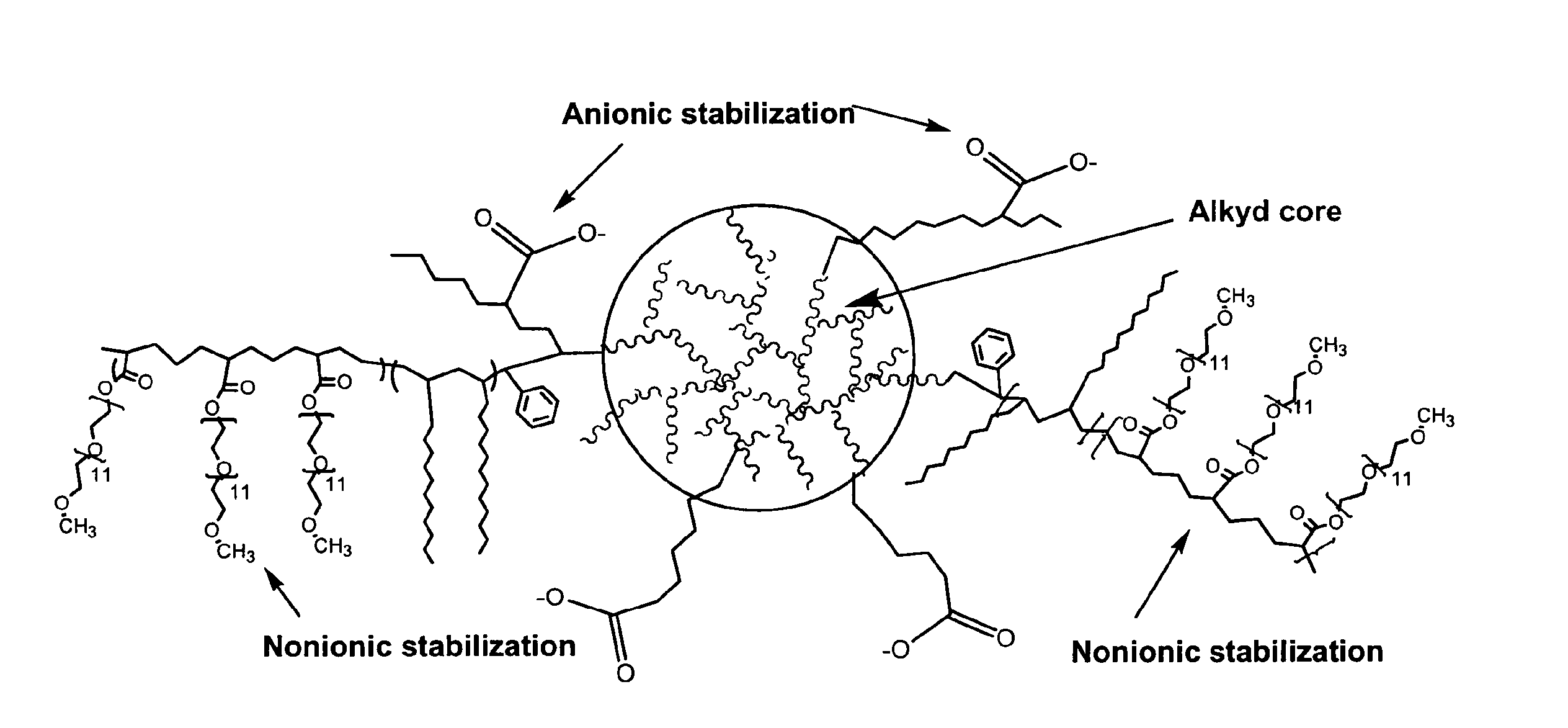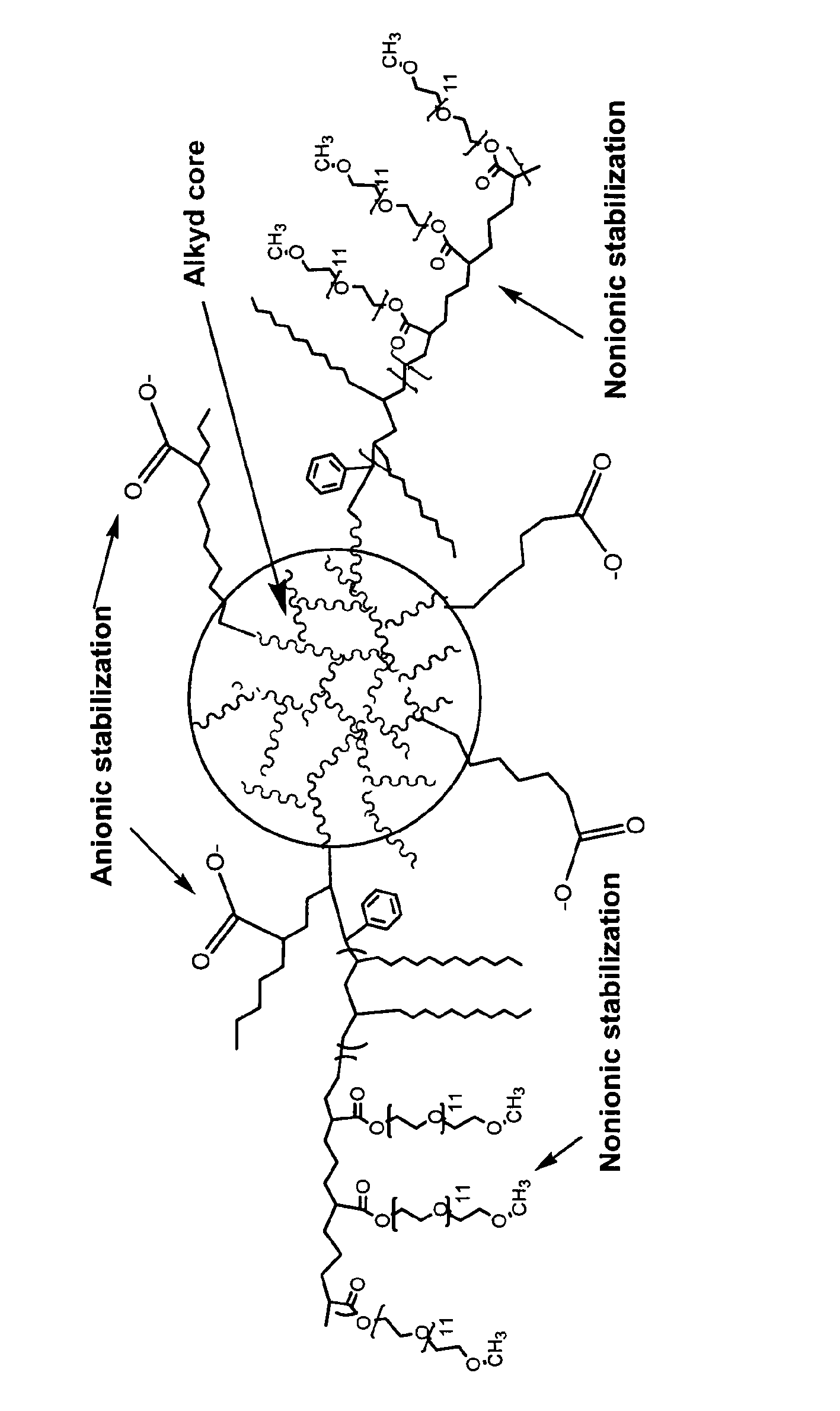Waterborne polymeric dispersions
a polymer dispersions and water-based technology, applied in the direction of adhesive types, graft polymer adhesives, coatings, etc., can solve the problems of poor hydrolytic stability, difficult to achieve the advantages of solvent-borne compositions, and difficult to achieve high gloss durable finishes
- Summary
- Abstract
- Description
- Claims
- Application Information
AI Technical Summary
Benefits of technology
Problems solved by technology
Method used
Image
Examples
example 1
[0102]Examples 1-A, 1-B, 1-C and 1-D illustrate, by way of non-limiting example, methods of making the hydrophobic polymers (II); the hydrophilic macromonomer (I); the polymeric composition comprising hydrophobic polymer (II), hydrophilic macromonomer (I) and bridging monomer (III); and the emulsions of the resulting polymeric composition of this invention.
example 1-a
Preparation of a Hydrophobic Alkyd Polymer (II)
[0103]A four-necked reaction flask equipped with a condenser; agitator; heating mantle; addition funnel; thermocouple attached to a control box (Love control series 32A); and primed Dean-Stark trap with methyl isobutyl ketone, was charged with 28.5 parts (by weight) of Pamolyn-200 (unsaturated fatty acid available from Hercules Pinova Products, having 77% linoleic acid and 22% oleic acid content), 28.5 parts of tall oil fatty acid, 22.4 parts of trimethylol propane, 20.2 parts of isophthalic acid, 0.4 parts maleic anhydride, 0.05 parts of Fascat 4350 (Butyl tin catalyst available from Arkema Inc.) and 2 parts methyl isobutyl ketone, and heated under 0.5 SCFH (standard cubic feet per hour) (0.014 m3hr-1) nitrogen flow to 165° C. At 165° C., water started to distil azeotropically. The reaction temperature was increased to 230° C. and maintained at such temperature until an acid value of less than 8 was attained. The Dean-Stark trap was dr...
example 1-b
Preparation of a Hydrophilic Macromonomer (I) (HL-block Type) Using AMSD (Alpha-methylstyrene Dimer)
[0106]A four-neck reaction flask equipped as in Example 1-A, was charged with 0.5 parts of methyl methacrylate, 6 parts of MPEG-550 (methoxy polyethyleneglycol methacrylate having Mn of 550), 5 parts of alpha-methylstyrene dimer and 13 parts of propylene glycol methyl ether and heated under a 0.2 SCFH (0.006 m3 hr-1) flow of nitrogen to 127° C. A monomer mixture of 4.5 parts of methyl methacrylate, 54 parts of MPEG-550, 2.8 parts of t-butyl peroctoate was then added over 4 hours via addition funnel. The temperature was increased to 132-135° C. throughout the monomer addition. A second monomer mixture composed of 5 parts methyl methacrylate, 25 parts lauryl methacrylate, 1.2 parts tert-butyl peroctoate and 3 parts glycol ether was added over 2 hours maintaining the temperature at 132-135° C. range. Heating was continued for an additional 1 hour at 132° C. The hydrophilic macromonomer t...
PUM
| Property | Measurement | Unit |
|---|---|---|
| Mass | aaaaa | aaaaa |
| Fraction | aaaaa | aaaaa |
| Temperature | aaaaa | aaaaa |
Abstract
Description
Claims
Application Information
 Login to View More
Login to View More - R&D
- Intellectual Property
- Life Sciences
- Materials
- Tech Scout
- Unparalleled Data Quality
- Higher Quality Content
- 60% Fewer Hallucinations
Browse by: Latest US Patents, China's latest patents, Technical Efficacy Thesaurus, Application Domain, Technology Topic, Popular Technical Reports.
© 2025 PatSnap. All rights reserved.Legal|Privacy policy|Modern Slavery Act Transparency Statement|Sitemap|About US| Contact US: help@patsnap.com


